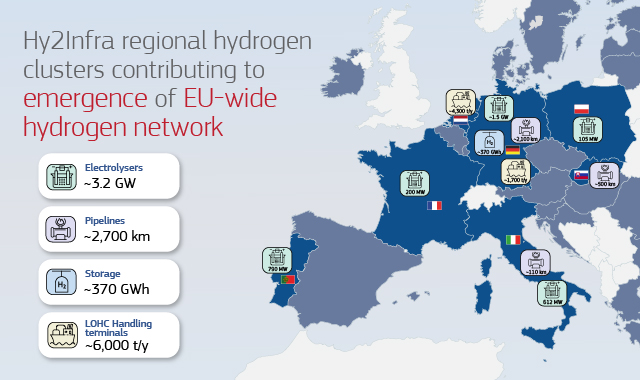The Commission has approved, under EU State aid rules, a third Important Project of Common European Interest (‘IPCEI’) to support hydrogen infrastructure. This IPCEI is expected to boost the supply of renewable hydrogen, thereby reducing dependency on natural gas and helping to achieve the objectives of the European Green Deal and the REPowerEU Plan.
The project, called “IPCEI Hy2Infra”, was jointly prepared and notified by seven Member States: France, Germany, Italy, the Netherlands, Poland, Portugal, and Slovakia.
The Member States will provide up to €6.9 billion in public funding, which is expected to unlock €5.4 billion in private investments. As part of this IPCEI, 32 companies with activities in one or more Member States, including small and medium-sized enterprises (‘SMEs’), will participate in 33 projects.
IPCEI Hy2Infra will cover a wide part of the hydrogen value chain by supporting:
- the deployment of 3.2 GW of large-scale electrolysers to produce renewable hydrogen;
- the deployment of new and repurposed hydrogen transmission and distribution pipelines of approximately 2,700 km;
- the development of large-scale hydrogen storage facilities with a capacity of at least 370 GWh; and
- the construction of handling terminals and related port infrastructure for liquid organic hydrogen carriers (‘LOHC’) to handle 6,000 tonnes of hydrogen a year.
Participants will also collaborate on interoperability and common standards to prevent barriers and facilitate future market integration. The IPCEI will support the gradual emergence of an EU-wide hydrogen infrastructure starting from different regional clusters.
Several projects are expected to be implemented in the near future, with various large-scale electrolysers expected to be operational between 2026 and 2028, and pipelines between 2027 and 2029 depending on the geographic area. The overall completion of projects is planned for 2029, with timelines varying depending on projects and companies.
IPCEI Hy2Infra complements the first and second IPCEIs on the hydrogen value chain. The Commission approved IPCEI “Hy2Tech” on 15 July 2022, which focuses on the development of hydrogen technologies for end users. IPCEI “Hy2Use” was approved on 21 September 2022 and focuses on hydrogen applications in the industrial sector. Hy2Infra concerns infrastructure investments, which are not covered by the first two IPCEIs.
Commission assessment
The Commission assessed the proposed project under EU State aid rules, more specifically its Communication on Important Projects of Common European Interest.
Where private initiatives supporting breakthrough innovation and the construction of large-scale infrastructure of great EU importance fail to materialise because of the significant risks such projects entail, IPCEI rules enable Member States to jointly fill the gap to overcome these market failures. At the same time, the rules ensure that the EU economy at large benefits from the investments and limit potential distortions to competition.
The Commission has found that the IPCEI Hy2Infra fulfils the required conditions set out in its Communication. In particular, the Commission concluded that:
- The project contributes to a common objective by supporting the deployment of hydrogen infrastructure important for achieving the objectives of key EU policy initiatives such as the European Green Deal, the REPowerEU Plan and the EU Hydrogen Strategy.
- All 33 projects included in the IPCEI are highly ambitious, as they aim at developing infrastructure that goes beyond what the market currently offers. They will lay the first building blocks for an integrated and open hydrogen network, accessible on non-discriminatory terms, and enable the market ramp-up of renewable hydrogen supply in Europe. This will allow for the decarbonisation of economic sectors that depend on hydrogen to reduce their carbon emissions.
- The IPCEI also involves significant financial risks. Therefore, public support is necessary to provide incentives to companies to carry out the investments.
- Aid to individual companies is limited to what is necessary and proportionate and does not unduly distort competition. In particular, the Commission has verified that the total planned maximum aid amounts are in line with the eligible costs of the projects and their funding gaps. Furthermore, if projects covered by the IPCEI turn out to be very successful, generating extra net revenues, the companies will return part of the aid to the respective Member State (claw-back mechanism).
- The technical knowledge and experience acquired during the construction and first years of operation of the projects will be widely shared by participating companies through publications, conferences, and joint recommendations for the development of operational rules and technical standards. As a result, positive spill-over effects will be generated throughout Europe, beyond the companies and Member States that are part of the IPCEI.
On this basis, the Commission concluded that the project is in line with EU State aid rules.
Funding, beneficiaries and amounts
The IPCEI will involve 33 projects by 32 companies, including five SMEs. The participating companies will closely cooperate through numerous collaborations, as well as with external partners, such as transmission system operators, potential off-takers, universities, research organisations, and equipment suppliers across Europe, including SMEs.
The figure below presents the workstreams of Hy2Infra, including the individual projects.

Several Member States (France, Germany, Poland and Portugal) included their participation in the IPCEI Hy2Infra in their Recovery and Resilience Plans and thus can partially fund some of their projects through the Recovery and Resilience Facility.
More information on the amount of aid to individual participants will be available in the public version of the Commission’s decision, once the Commission has agreed with Member States and third parties on any confidential business secrets that need to be removed.
Source: European Commission | Press Corner (https://shorturl.at/auGJX)
